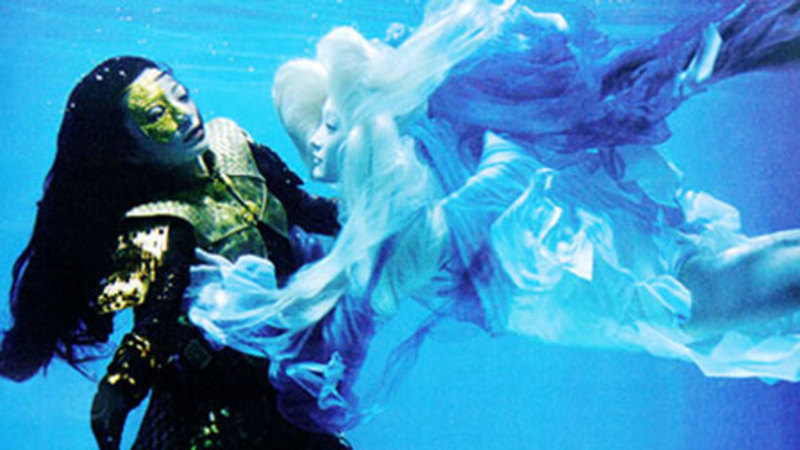Despite Warner Bros. having restored and restored this MGM classic just a few years earlier, for the 70th Anniversary Edition the studio went back and rescanned the entire movie at an even higher resolution, remastering it for the DVD edition reviewed here and a Blu-ray edition as well. Needless to say, it looks better than ever, which, for a film that already looked awfully good, is saying a lot.
“Gone with the Wind,” David O. Selznick’s 1939 production of Margaret Mitchell’s epic story of the Civil War and the Old South, is probably the granddaddy of all blockbusters. “Birth of a Nation” may have preceded it as the first true superspectacular, and “Titanic” may have come after it as the biggest moneymaking film of all time, but I predict that fifty years from now, when most people have forgotten “Nation” and the waters of time have settled down around the big sinking boat, “Gone with the Wind” will still be most people’s idea of THE big-scale movie. Understand, I’m not suggesting it’s the best film ever made, or even my favorite film, but I have to rank it among the most deservedly popular films ever created. After all, it does continue to hold the record for being the best-attended movie of all time.
Besides, for good or for bad it’s probably the film more people have talked about over the years than any other. The American Film Institute voted it the fourth best American movie ever made. “Entertainment Weekly” placed it eighth on their list of “The 100 Greatest Movies of All Time.” “Variety” called it “One of the truly great films.” Roger Ebert claims “it is still a great film, above all because it tells a great story.” The “Daily Mirror” said it was “still pure gold.” And Leonard Maltin asserted, “If not the greatest movie ever made, certainly one of the greatest examples of storytelling on film, maintaining interest for nearly four hours.” On the other hand, critic Franz Hoellering wrote in “The Nation” that the film was “a major event in the history of the industry but only a minor event in motion picture art.” The London “Sunday Times” drama critic James Agate said “Shakespeare’s ‘Taming of the Shrew’ seems to have got mixed up with one of the novels of Ethel M. Dell.” And “Time Out” magazine called it “perhaps the key plantation movie.”
Maybe producer Irving Thalberg said it best when he remarked to Louis B. Mayer in 1936, “Forget it, Louis, no Civil War picture ever made a nickel.” Controversy then; controversy now. Well, the movie did make over a nickel, but it’s still got its detractors, most notably those who claim, not unjustifiably, that it’s is the most glorified soap opera ever made.
I hardly need recount the story, based on novelist Mitchell’s sprawling Civil War concoction, the on-again off-again love story of Scarlett O’Hara (Vivien Leigh) and Rhett Butler (Clark Gable). Suffice it to say that the movie is melodrama at its best, with enough romance and adventure to have satisfied audiences for over seventy years. But it was not an easy production, and it’s a wonder it came off as coherently as it did considering the number of directors called upon to complete it, among them George Cukor, Sam Wood, and production designer William Cameron Menzies. However, the director most credited for the film’s success is Victor Fleming, whose name appears in the credits. He and the others managed to fashion a piece of timeless storytelling, aided by a fine supporting cast headed up by Olivia de Havilland, Leslie Howard, Thomas Mitchell, Hattie McDaniel, and Butterfly McQueen. Together, they tell a story of huge proportions, one that spans many years and encompasses spectacles like the siege and burning of Atlanta that continue to impress today.
Why has it remained so popular? I suspect that in addition to the film’s spectacle–the picnic at Twelve Oaks, the lavish balls, the great crane shot of War victims sprawled for miles, the burning of Atlanta, the ravishing matte paintings–it’s all about the cast and the casting. Clark Gable’s Rhett Butler is among the screen’s most-enduring heroes, right up there with Humphrey Bogart’s Rick Blaine, Sean Connery’s James Bond, Harrison Ford’s Indiana Jones, and the AFI’s Gregory Peck as Atticus Finch in “To Kill a Mockingbird.”
The other characters are more problematical, starting with Vivien Leigh’s Scarlett O’Hara, a spiteful, spoiled brat who nevertheless shows a determination that has been awe-inspiring for decades. Olivia de Havilland’s Melanie Hamilton is probably a character too good to be true, but, hey, she, too, has continued to be an inspiration for good. The weak point may be Leslie Howard’s Ashley Wilkes, a rather weak-kneed stuffed shirt and a wimp regarding Scarlett. Fortunately, there is Hattie McDaniel’s strong-willed nursemaid, Mammy, a role that helped McDaniel become the first African-American to win an Academy Award; and there is Thomas Mitchell’s convincing Pa, Gerald O’Hara, and Butterfly McQueen’s endearingly harebrained house servant, Prissy.
It amazes me that the film continues to maintain my attention for nearly four hours, despite my having seen it a dozen times since childhood. OK, I have to admit I always start to tire in the second half, but, thankfully, modern disc playback makes it easier than ever to come and go in the story. Has it dated at all? Not a bit. It’s as fresh today as the night it premiered, thanks in part to its new restoration and remastering. The film won eight Academy Awards, for Best Picture, Director, Actress, Supporting Actress, Writing, Art Direction, Cinematography, and Film Editing. It was producer David O. Selznick’s crowning achievement and a film that stands up as one of the screen’s finest classics.
Certainly, I welcome the appearance of “Gone with the Wind” in all the splendor of its newly restored and remastered edition. Unless you watch it in high-definition Blu-ray, the film surely has never looked so good, even in a first-run movie house.
Trivia notes, courtesy of John Eastman, “Retakes,” Ballantine Books, 1989: “From the start, Gable was slated to play Butler–though the actor felt the role lay beyond his talents. Intimidated by a part that required more complex self-exploration than any of his previous (or later) roles, he strongly protested the scene that required him to cry after hearing of Scarlett’s miscarriage. Shedding tears, he believed, would risk his carefully nurtured macho image. He even threatened to walk off the picture and give up his career. Only by subtle handling could director Victor Fleming persuade him to rehearse the scene both with and without the tears; then Fleming used the weeping scene after assuring Gable that it would enhance, not destroy, his image.
Twenty-eight-year-old Butterfly McQueen, playing Prissy, didn’t like playing a slave, but the money helped her through U.C.L.A., and years later she made a part-time career of reminiscing to audiences about the film. Look for TV’s first Superman, George Reeves, as Stuart Tarleton in the opening scene at Tara. Eddie Anderson, Jack Benny’s longtime sidekick, appears as Uncle Peter. And the white horse ridden by Thomas Mitchell later became the Lone Ranger’s Silver.”
Video:
Warner Bros. digitally restored and remastered the film for their 2005 edition, and this time they have scanned it at an even higher resolution before downscaling it to standard-definition DVD. It continues to be nothing short of astonishing for a film of its age (or for a film of any age). The Technicolor is vivid and lifelike, producing more natural, realistic facial tones than before, slightly richer, deeper, more textured colors, and better contrasts. With a cleaner screen, whiter whites and blacker blacks, and even sharper delineation, you get an image quality that’s better than ever.
The new transfer appears more true-to-life than ever, too, and there is nothing about the movie that betrays its age save possibly the fact that the filmmaker never produced it in widescreen (although for its 1967 theatrical rerelease, the studio matted it for 2.20:1 widescreen exhibition, cutting off huge chunks of the top and bottom of the screen, destroying the visual composition of the scenes, and enraging film buffs everywhere). Now, the whole movie radiates a freshness and beauty hard to imagine in a source seven decades years old. It’s hard to argue with the new remaster’s success.
Audio:
As with the previous edition, this new Anniversary Edition has both a Dolby Digital 5.1 soundtrack and an original monaural track. The monaural is a quaint nod to historical accuracy, but the newer track, especially Max Steiner’s magnificent music, is distinctly preferable in 5.1 multichannel and will undoubtedly please everyone but purists. The surround mode does not provide the discrete five-channel sonics that a completely up-to-date soundtrack would afford, but it is pleasantly enveloping, and the added stereo effects like cannon shots and explosions are effectively convincing. My only quibble would be that the overall sound is a tad forward, thin, and edgy, more so in the original mono but noticeable in the 5.1 remix as well.
Extras:
In this movie-only edition Warner Bros. present the film on two discs, with little else. Along with an audio commentary by film historian Rudy Behlmer, you get sixty-three scene selections; English, French, Spanish, Portuguese, and Japanese spoken languages; French, Spanish, Portuguese, and Japanese subtitles; and English captions for the hearing impaired. Additionally, the discs come with a coupon for a “GWTW” poster, and the double-disc keep case comes housed in an embossed cardboard slipcover. (Note, however, that neither the keep case nor the slipcover provides the correct information for spoken languages or subtitles.)
For fans wanting more than just the remastered movie, Warners also make the film available in a superdeluxe, five-disc standard-definition box and a two-disc Blu-ray box, both of them containing documentaries, interviews, trailers, booklets, and enough other material to keep a person busy watching longer than the duration of the Civil War.
Parting Thoughts:
OK, I sense that some of you out there still want to convince me that Leonardo DiCaprio and Kate Winslet make better romantic leads than Clark Gable and Vivien Leigh. Well, “Frankly, my dear, I don’t give a damn.”


